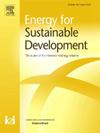评估大都市周边工业园区的光伏安装潜力:监管障碍和地理因素
IF 4.4
2区 工程技术
Q2 ENERGY & FUELS
引用次数: 0
摘要
评估工业园区的光伏(PV)安装潜力对于推进可再生能源目标至关重要,尤其是在韩国京畿道这样的城市化环境中。本研究探讨了影响 193 个工业园区光伏发电可行性的地理、法规和环境因素之间复杂的相互作用。研究采用基于地理信息系统的方法,对总面积达 47.3 平方公里的可用屋顶和一般土地进行了评估,估计光伏发电能力潜力为 3.72 千兆瓦。尽管大量屋顶空间主要位于混凝土结构上(10 平方公里),但严格的后退规定带来了巨大障碍,尤其是在安山等地区。占地 16.6 平方公里的一般土地前景看好,尤其是在平泽。当前的监管挑战,包括后退规定,阻碍了 3.8 千兆瓦光伏发电能力目标的实现,凸显了政策改革对促进部署的潜在益处。本研究强调了光伏发电在可持续能源转型中的关键作用,并倡导进行战略性改革,使监管框架与可再生能源目标相一致。通过将地理信息系统(GIS)分析与监管见解相结合,本研究为空间规划举措提供了信息,这些举措对于扩大太阳能在工业领域的贡献至关重要,有助于为实现低碳未来做出明智决策。本文章由计算机程序翻译,如有差异,请以英文原文为准。
Evaluation of photovoltaic installation potential in industrial complexes around metropolitan areas: Regulatory obstacles and geographical considerations
The assessment of photovoltaic (PV) installation potential in industrial complexes is critical for advancing renewable energy objectives, particularly in urbanized settings like Gyeonggi Province, South Korea. This study examines the complex interaction of geographical, regulatory, and environmental factors affecting PV feasibility across 193 industrial complexes. Employing a GIS-based methodology, the research evaluates available rooftop and general land areas totaling 47.3 km2, estimating a PV capacity potential of 3.72 GW. Despite significant rooftop spaces predominantly on concrete structures (10 km2), stringent setback regulations present substantial obstacles, particularly in areas such as Ansan. General land sites covering 16.6 km2 offer promising prospects, notably in Pyeongtaek. Current regulatory challenges, including setback regulations, impede the realization of the targeted 3.8 GW PV capacity, highlighting the potential benefits of policy reforms to facilitate deployment. This study underscores PV's pivotal role in sustainable energy transitions and advocates for strategic reforms to align regulatory frameworks with renewable energy aspirations. By integrating GIS analyses with regulatory insights, the study informs spatial planning initiatives essential for scaling up solar energy contributions in industrial contexts, supporting informed decision-making toward achieving a low-carbon future.
求助全文
通过发布文献求助,成功后即可免费获取论文全文。
去求助
来源期刊

Energy for Sustainable Development
ENERGY & FUELS-ENERGY & FUELS
CiteScore
8.10
自引率
9.10%
发文量
187
审稿时长
6-12 weeks
期刊介绍:
Published on behalf of the International Energy Initiative, Energy for Sustainable Development is the journal for decision makers, managers, consultants, policy makers, planners and researchers in both government and non-government organizations. It publishes original research and reviews about energy in developing countries, sustainable development, energy resources, technologies, policies and interactions.
 求助内容:
求助内容: 应助结果提醒方式:
应助结果提醒方式:


